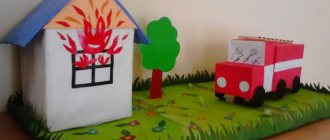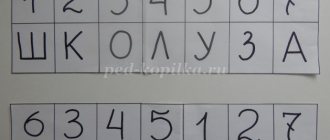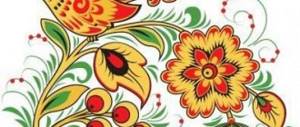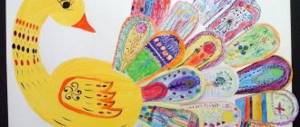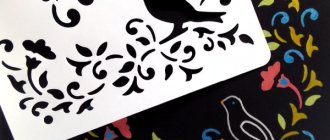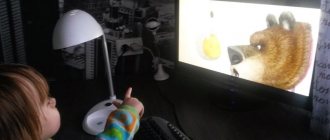How should classes be conducted?
Children learn lessons better in a playful way. The following will help your baby become familiar with the number 2:
- coloring books;
- pencils;
- counting sticks (apples, cubes, balls, etc.);
- benefits;
- video lessons;
- outdoor games;
- poetry.
Psychological attitude
It is important to maintain a pleasant atmosphere throughout the lesson.
The child will benefit from not only the auditory, but also the visual association. Alternating image and audio, consolidating information. Example: a cartoon with a favorite character, where they tell him about the number 2.
In the next lesson, draw circles (apples, mushrooms). Get ready to constantly show and say the number 2 to your baby.
Getting to know digital
- Let's start the lesson with rhymes:
Pay attention to the baby that the ears have a pair and the eyes have a pair.
Continue:
There are two arms and two legs. A couple of birds on the window. It’s easy to remember two: mom and dad are two adults.
When reciting the poem, do not forget to show the arms and legs.
2. Try the exercise:
Take the child's hand. Bend your fingers so that the index and middle fingers remain. Repeat: “This is also 2”
3. Next, move on to working with cards or pictures.
And this is number two. Admire how it looks: The deuce arches its neck, Its tail drags behind it.
4. Ask your child: “Who is 2 like?”
5. Show a card with a picture of a swan. Ask the question: “Who is in the picture?”
6. Next task: “Count the number of objects.” In front of the child lie geometric shapes: 3 circles, 2 squares, 1 triangle.
Ask your child to indicate the number being studied.
Physical warm-up
- Physical exercise. Do a little exercise:
Hands-handles - stretching (reaching towards the sun), And palms - TWO firecrackers (clap our hands), Legs-legs - stomping (we stomp our feet),
Like frogs - jumping (we jump), Good morning, number 2. Well, it’s time for us to play (let’s run, run away).
2.Next exercise:
Hello, hello, Aunt Two!
The kids have come running!
Hands clap-clap Legs top-top Hands up and up Who is taller than everyone today?
3. Place 2 balls in front of the child and ask him to perform some action - throw, kick or bring to the basket. Repeat counting objects: one, two.
4. Also do an exercise with tossing a ball:
Teacher: “(NAME), there are 2 balls in front of you. Shall we play? Will you try to throw both balls into the basket?
5. Do exercises with mental counting (squats). Smile. Tell a funny poem:
They sat down and stood up, sat down and stood up. We reached the ground with our hand. They stamped their feet and clapped their hands.
ONE, TWO! ONE, TWO!
The kids are not lazy.
6. Show a picture of a deuce. Ask your child to depict her with his body. “It turned out to be a swan.”
Written work with elements
1. Teacher: “Take a piece of paper and a colored pencil. Draw a sun, then another sun. How much did you get?
Children: “2 suns”
Be sure to praise. Instead of the sun there may be other objects: a flower, a house, a snowman or a snowflake. The main task is to show the couple.
2. Next exercise: “Equally.”
Teacher: “You have 2 apples. They can be divided equally. How? 1 apple for you and 1 apple for mom, and together there will be 2!”
Working on developing your horizons
When learning is fun, the child remembers better. By influencing the baby’s emotions, attention is sharpened, promoting a positive attitude and activation of mental activity.
Surprise awakens interest in knowledge, the desire to search, explore, create and develop ingenuity. Therefore, it is necessary to put into practice a variety of ways to support children’s cognitive interests.
Drawing numbers
Let's help the baby. Take a pencil and a notebook in a large square. We correctly place a pencil in the child’s hand and draw the number 2 with it.
Notes on FEMP in the preparatory group
Shaigardanova R.V. Notes on FEMP in the preparatory group // Sovushka. 2020. N3(13). URL: https://kssovushka.ru/zhurnal/13/ (date of access: 10.10.2020).
Order No. 115203
Objectives of the quest: to activate the cognitive and mental processes of participants, to implement gaming activities.
Tasks for FEMP:
Educational:
1. Continue to teach the difference between quantitative and ordinal counting within 10, and correctly answer the questions: how much? which one?
2. Introduce the formation of the number 12.
3. Fix the composition of the number 7 from the two smallest numbers.
Developmental: develop logical thinking.
Educational: understand the learning task and complete it independently.
Equipment: interactive whiteboard, easel , letter from Dunno, typesetting canvas with 7 squares of two colors for each child; tulips of two colors, made by children from colored paper using the origami method; slide presentation for completing a task to consolidate quantitative ordinal counting; a sheet of Whatman paper, a felt-tip pen, cards for each child in the form of cakes decorated with berries in a certain pattern.
Progress of the lesson:
Organizing time.
Guys, let's go to the mat and stand in a circle, hold hands and get ready for joint activities:
We will build an even circle,
On the right is a friend and on the left is a friend.
Let's hold hands together
And let's smile at each other.
Educator: Guys, Dunno sent us a letter again. Dunno asks us for help again. Shall we read his letter? The children agree.
The teacher reads the letter: “Hello, dear children! You have already helped me more than once - and for that I am very grateful to you. But today I again turn to you for advice: “Teach me how to prepare for the holiday, since my girlfriend invited me to her birthday? (Dunno)"
Educator: Our Sabrina also has a birthday soon. Therefore, it will also be useful for us to remember how to prepare for the holiday - Birthday.
Educator: Well, let's help Dunno?
The children agree.
Educator: Then tell me how to prepare for the holiday - Birthday.
Children speak out about how to prepare for the holiday.
Educator : I am very glad that you know a lot about how you can organize a holiday and can teach Dunno to prepare for it. But let’s formalize the answer to him about this in the form of a hint diagram. Do you agree?
The teacher invites the children to sit on chairs in front of the board. The teacher sets up an easel with a sheet of Whatman paper to schematically depict future stages of work on it.
Educator: everyone agrees that you first need to find out what the birthday boy dreams of in order to choose for him the gift that he will like? how can you depict this?
The teacher notes on a piece of Whatman paper: 1. (draws, for example, a box with a bow and puts a question mark).
Educator: But it often happens that you don’t have money and it’s impossible to buy a gift. How to solve a problem? You offered to make a gift with your own hands. How can you depict this?
The teacher notes on a piece of Whatman paper: 2. (draws, for example, a hand).
Educator: and you said that it is necessary to come with a treat. How can you depict this?
The teacher notes on a piece of Whatman paper: 3. (draws, for example, a cake).
Educator: now let's check if we are right? I propose to start preparing for Sabrina's birthday. Do you agree? What do we do? Where do we start?
1. Children, turning to the diagram, determine what needs to be found out, what does Sabrina dream about?
Educator: I found out what Sabrina dreams about. She dreams of 12 gifts. Let's see what her family has already prepared for the girl.
The teacher shows a slide where 10 objects are depicted in one row.
Educator: But in order to move on, you must determine in what place each item is placed and how many items there are.
The teacher asks the children questions:
— Where is the comb? (The comb is in eighth place.)
— Where is the box? (The box is in fifth place.)
- Where is the mirror in? (The mirror is in second place.)
— Where is the cake? (Cake comes first.)
- Where is the doll in? (The doll is in third place.)
- Where is the ball in? (The ball is in fourth place.)
- Where are the beads in? (Beads are in sixth place.)
- Where is the plate in? (The plate is in seventh place.)
- Where are the earrings? (Earrings are in tenth place.)
— Where is the clock? (The clock is in ninth place.)
- How many gifts are there in total? (10)
The teacher draws the children's attention to the fact that Sabrina dreams of 12 gifts.
2. The teacher asks the children questions:
How many gifts do we need to give to make them 12? (2)
Educator: I suggest we find two more gifts. I can give you soap bubbles. Do you think she will like this gift? What can you give? Children come to the conclusion that they can give flowers.
The teacher adds 2 more gifts on the slide and puts them in a row with other items. (soap bubbles and a bouquet of flowers).
How many items did you get? 12
How did we get the number 12? (2 added to 10)
How can you get the number 12? How many tens and ones are in the number 12? (one ten and 2 units).
The teacher invites the children to come to the table with handouts and make up the number 12 from them.
Children complete the task. The teacher asks 3-4 children how they came up with the number 12.
The teacher sums it up: well done, you know how to answer questions correctly: how much? which one? You have correctly identified the location of each object and know how the number 12 is formed .
Physical exercise. Educator: I propose to play a fun game “The Sea is Troubled,” which can be played at any holiday.
3. Educator: Guys, we recently made a lot of tulips using the origami method, and now I propose to collect bouquets from them for Sabrina. Do you agree?
Educator: we need to make bouquets of tulips so that there are 7 flowers in the bouquet, since Sabrina will be 7 years old. But you need to collect 7 flowers in different ways.
Educator: I suggest you go to your places at the tables and, using our teaching aids, determine how we can make the number 7 in different ways from the two smallest numbers.
The children take their places. (Each child has a typesetting canvas with 6 rows of blue squares on the table. If the squares are turned over, they will be green).
The teacher suggests counting the squares in each row.
Children count the squares.
The teacher asks the question: how many blue squares are there in each row? (7 each)
The teacher performs actions with the objects of the manual on the board and encourages children to participate in the activity:
- We will take one blue square from the left edge in the first row and turn it over. What does this series look like now? How many and what kind of squares did we get in this row? (1 green square and 6 blue squares). How many are there in total in a row? (7) Let’s write down an expression about how we got the number 7. (1+ 6=7) The teacher invites one or two children to read the expression.
- Now let's turn over 2 squares in the second row. What happened? (2 green squares and 5 blue squares). Let's write down the expression (2+5=7). The teacher invites one or two children to read the expression.
- Let's turn over 3 squares. What happened? (3 green squares and 4 blue squares). Let's write down the expression (3+4=7). The teacher invites one or two children to read the expression.
- Let's turn over 4 squares. What happened? (4 green squares and 3 blue squares). Let's write down the expression. (4+3=7). The teacher invites one or two children to read the expression.
- Let's turn over 5 squares. What happened? (5 green squares and 2 blue squares). Let's write down the expression. (5+2=7). The teacher invites one or two children to read the expression.
Let's turn over 6 squares. What happened? (6 green squares and 1 blue square). Let's write down the expression. (6+1=7). The teacher invites one or two children to read the expression.
How many options did you get? (6)
Each child composes the number 7 on his or her manual in different ways and writes down the expressions.
The teacher invites the children to choose one option for making a bouquet and find a friend who chose the same option. The children are divided into pairs and collect bouquets of tulips for Sabrina.
The teacher sums up: what wonderful bouquets we got. Well done, you now know how to form the number 7 from the two smallest numbers in different ways.
4. What else should we do? Let's look at our board. Children answer the question. (come with a treat).
Educator: I suggest you decorate these cakes with berries. The teacher gives the children cards in the form of cakes.
Educator: Think about what berry you need to add to this cake in order to comply with the given pattern? Find the pattern and draw the corresponding patterns of the berry.
The teacher sums it up: Guys, you did great, you coped with the task because you know how to find patterns.
Educator: You are also great because I saw that all your holidays will be fun and interesting, because you know how to choose gifts and prepare them with your own hands, and you will even be able to please every guest - decorate a cake for him with an unusual design.
Can we send a message to Dunno? (Yes.)
The teacher takes pictures of the diagram, children with bouquets, children with decorated cards - cakes, and sends messages to Dunno via e-mail on the phone.
Reflection.
Educator: Did you like our lesson? What new did you learn today? What task was difficult for you? Was it difficult for you to come to an agreement as a couple? What will you need in life?
